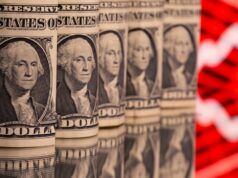Asian currencies tread water; yuan down after RRR cut
MOST EMERGING Asian currencies were kept in check on Wednesday, as the dollar gained on firm US economic data and as US-China trade risks and tensions in the Middle East appeared to take a backseat for now.
The yuan pulled back after the People’s Bank of China (PBoC) surprised markets late on Tuesday by cutting reserve requirements, although the move fell short of a broad easing in monetary conditions.
The dollar index against a basket of six major currencies was a shade higher at 89.538 after gaining 0.1% overnight.
The index had stooped to 89.229, its lowest since March 27 before retreating on stronger-than-expected March US housing starts and steady industrial production figures.
The dollar took a small knock earlier in the week after US President Donald Trump criticized the currency policies of China and Russia, before finding relief after Treasury Secretary Steve Mnuchin clarified Mr. Trump’s comments on Tuesday.
“It’s very, very quiet today. Traders remain very cautious adding regional risk due to the overhang from the trade war,” said Stephen Innes, head of trading APAC at Oanda.
The rupee fell as much as 0.2% to its lowest level since September.
The Philippine peso also lost about 0.2% and was on track to mark its third consecutive session of declines.
The rupiah, ringgit, and yuan were all little changed.
The won tacked on 0.1% to a one-week high, while the Singapore dollar, the Taiwan dollar and the baht also crept up slightly.
“The won is up on the peace treaty and the high level political discussions this has triggered. This will ultimately be good for regional FX, but in the meantime traders remain extremely cautious adding regional rush dye to the overhang from trade wars,” said Mr. Innes.
South Korea said on Wednesday it is considering how to change a decades-old armistice with North Korea into a peace agreement, as US officials confirmed an unprecedented top-level meeting with the North Korean leader.
The yuan slipped against the dollar on Wednesday, after the central bank surprised markets by cutting the amount of reserves banks must keep on reserve, raising some concerns over the health of the economy.
The move late Tuesday by the People’s Bank of China came hours after data showed the world’s second-biggest economy grew at a slightly faster-than-expected pace of 6.8% in the first quarter, buoyed by strong consumer demand and robust property investment.
Traders said the sudden RRR cut weighed on the yuan in morning trade as the amount was larger than expected and had come earlier than most had predicted.
Oanda’s Mr. Innes also suspects the market is of the view that China’s GDP data “could be a high point of the year”, noting risks from the tariff row with the United States and Beijing’s extended deleveraging campaign.
“In other words Q2 GDP could be worse than expected.”
Indeed, analysts are still predicting China’s economic growth will slow to 6.5% this year, with the ongoing regulatory crackdown and US trade dispute seen as key risks, a Reuters poll showed. — Reuters



